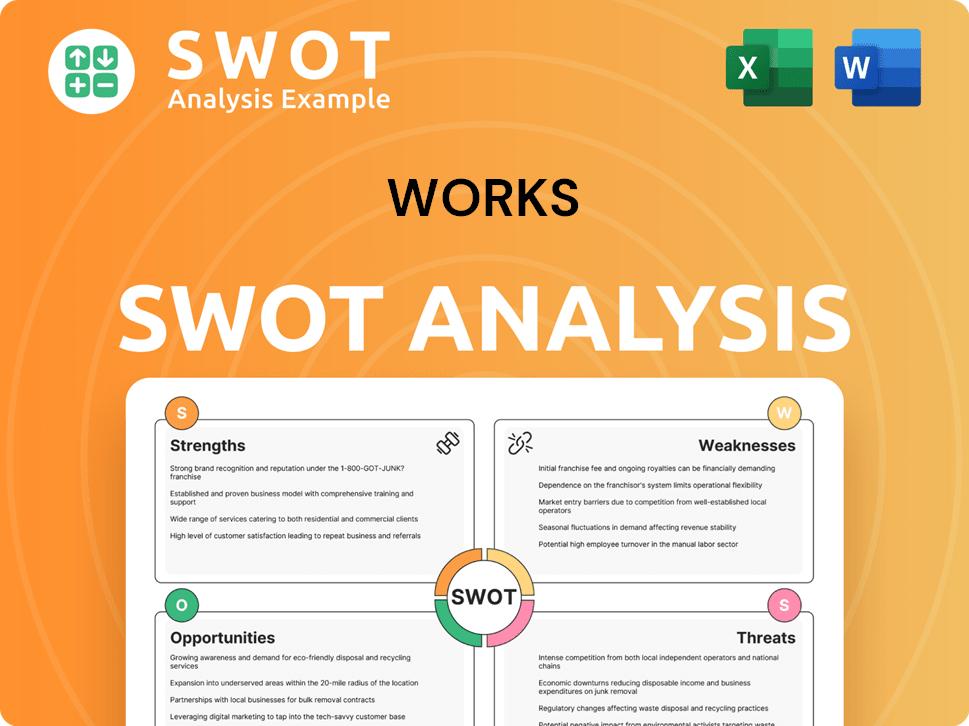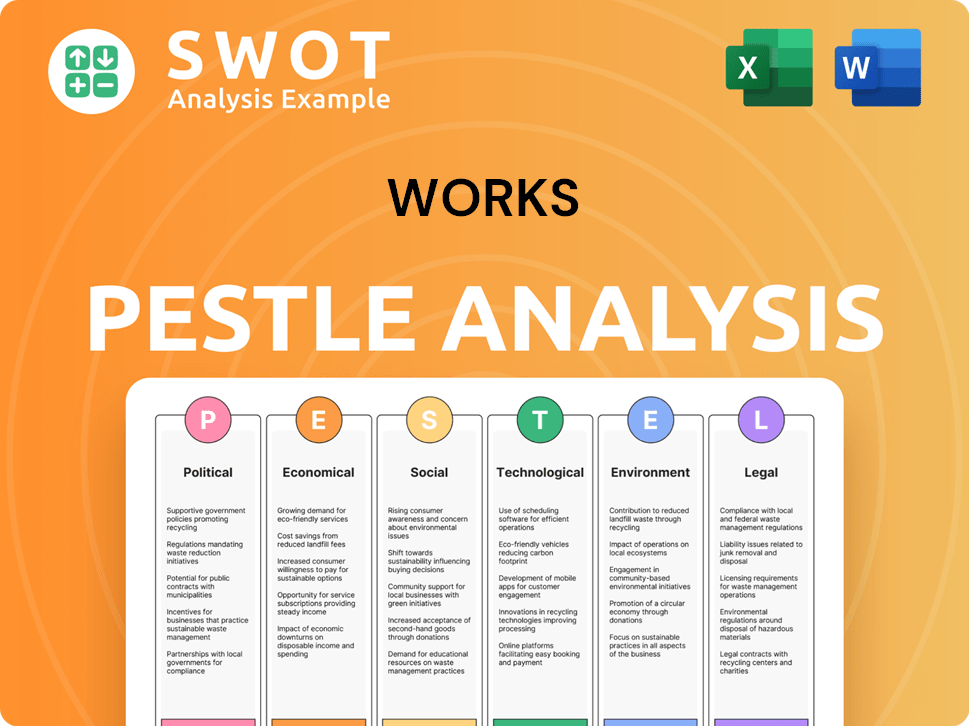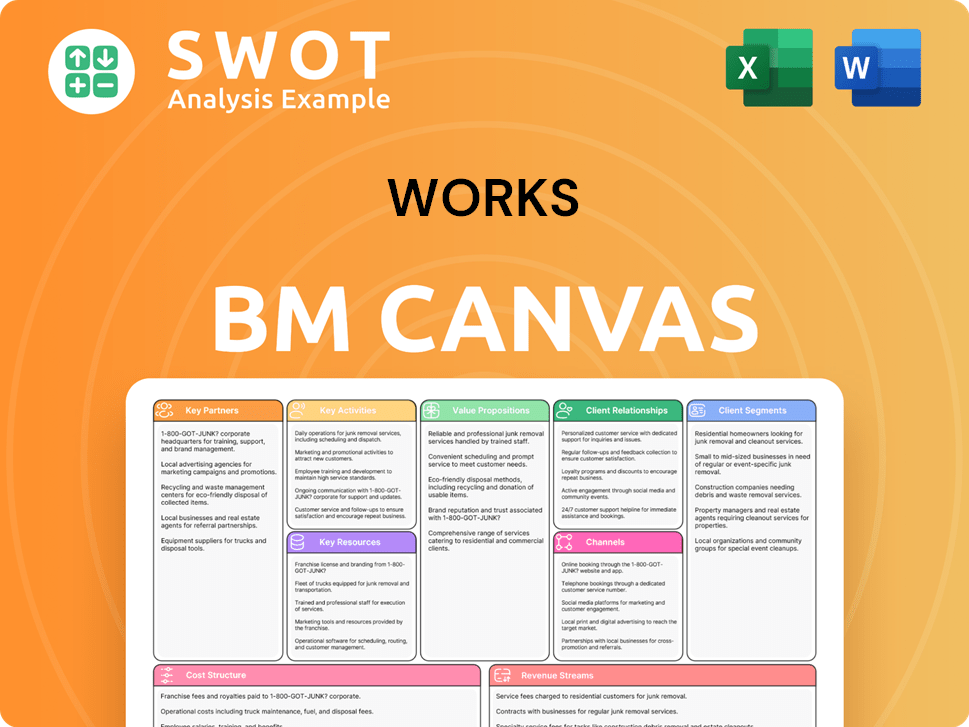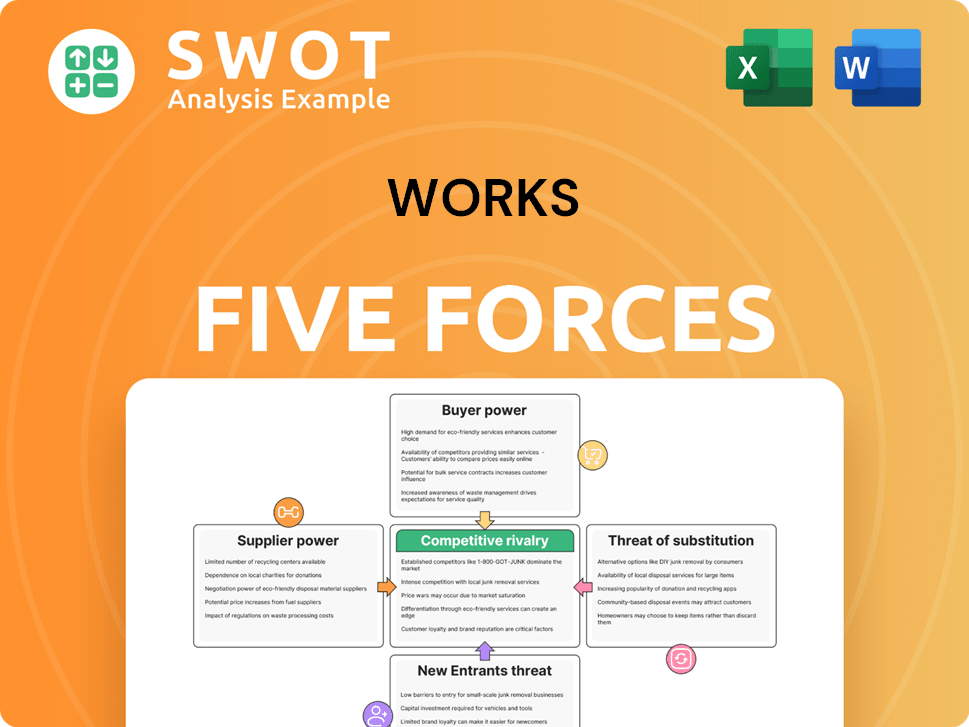Works Bundle
How Does The Works Company Thrive in a Changing Market?
The Works, a leading UK discount retailer, offers a wide array of products, from books to art supplies, captivating a broad customer base. Its value-driven approach has cemented its position in the retail landscape, operating over 500 stores as of May 2024. Navigating economic pressures, The Works demonstrates resilience and strategic adaptability.

This analysis will explore the Works SWOT Analysis, examining its company operations, business model, and company structure to uncover its strategies for success. We'll dissect how this works company generates revenue, its business processes, and its plans for future growth, providing valuable insights for investors and industry watchers. Understanding the company functions and works company day-to-day activities is key to appreciating its market position.
What Are the Key Operations Driving Works’s Success?
The core operations of the works company revolve around providing a diverse range of products across specialist categories. These include books, arts & crafts, toys & games, and stationery, complemented by seasonal offerings. The company aims to inspire customers to read, learn, create, and play, enhancing their lives. This is achieved through a multi-channel experience, encompassing retail stores and an online platform.
The company's business processes involve designing and innovating new products, sourcing and distributing them, and selling them through convenient channels. They identify and bring desirable and on-trend products to the UK market, including unique own-brand items developed by an in-house design studio. The company's focus is on offering value and quality, catering to a broad customer base.
The works company's business model is built on an opportunistic purchasing strategy and a 'better, not just bigger' approach. This strategy shifts the perception from a discounter to a retailer that inspires reading, learning, creativity, and play. The company's core capabilities provide affordable, screen-free activities for families, with a refreshed product offering that includes own-brand items and a growing share of the book market.
The company's experienced buying team curates product ranges, including popular brands and own-brand offerings. They work with around 250 suppliers across the UK, Europe, and Asia. Approximately 6,500 new product lines were introduced in FY24. The in-house design studio plays a key role in developing unique own-brand products.
Warehousing and store distribution are managed from a 157,000 sq ft facility in Coleshill, Birmingham. Online orders are fulfilled by a third party or picked in-store. This efficient system ensures products reach customers through various channels. The company focuses on optimizing its supply chain for effectiveness.
The company strives to create a positive customer experience through its retail stores and online platform. They aim to provide affordable, screen-free activities for the whole family. The company's focus on customer satisfaction is a key aspect of its operations.
The company offers a wide variety of good quality, great value products across specialist categories. Its purpose is to inspire customers to read, learn, create, and play, making lives more fulfilled. The company's value proposition is centered on providing affordable and engaging products.
The company's success is driven by its opportunistic purchasing strategy and its commitment to a 'better, not just bigger' strategy. This approach allows the company to offer a continuously fresh product range and adapt to changing consumer preferences. For more details, you can explore the Marketing Strategy of Works.
- Focus on own-brand products and a growing share of the book market.
- Efficient warehousing and distribution from a central facility.
- Strong supplier relationships to ensure product quality and safety.
- A multi-channel approach, including retail stores and an online platform.
Works SWOT Analysis
- Complete SWOT Breakdown
- Fully Customizable
- Editable in Excel & Word
- Professional Formatting
- Investor-Ready Format

How Does Works Make Money?
Understanding the revenue streams and monetization strategies of a company is crucial for assessing its financial health and future prospects. This section delves into how the company generates income and the methods it employs to maximize profitability. Analyzing these aspects provides insights into the company's operational efficiency and its ability to adapt to market changes.
The company, a retail business, primarily focuses on selling a diverse range of products, including books, stationery, and toys. Its revenue model is built upon a combination of in-store and online sales, with a significant emphasis on maintaining affordable prices to attract a broad customer base. The company's strategic decisions and operational adjustments reflect its commitment to enhancing profitability and customer satisfaction.
The company's primary revenue streams are derived from two main channels: in-store sales and online sales. In-store sales constitute the majority of the company's revenue, accounting for approximately 90% of total sales in FY24. This highlights the importance of its physical retail presence and the role of its stores in driving sales. The company's online sales, while smaller, contribute to overall revenue and provide an avenue for reaching a wider customer base.
In the 53 weeks ended May 5, 2024 (FY24), the company reported total revenue of £282.6 million. During the 26 weeks ending November 3, 2024 (first half of FY25), total revenue increased by 1.3% to £124.2 million. This indicates a positive trend in overall revenue generation. The company's ability to maintain and grow revenue is critical for its long-term success. Further insights can be found in Growth Strategy of Works.
- In FY24, store like-for-like sales grew by 0.6%.
- In the first half of FY25, store like-for-like sales increased by 0.9%.
- Online like-for-like sales declined by 12.4% in FY24.
- Online like-for-like sales declined by 14.7% in the first half of FY25, influenced by reduced promotional activities and challenges with its third-party online fulfillment center.
The company employs several monetization strategies to enhance its profitability. A key focus is maintaining everyday affordable prices to appeal to a broad customer base. In March 2024, the company ended its 'Together Rewards' loyalty scheme to reduce costs and maintain competitive pricing, prioritizing affordable prices for its customers. This decision aimed to improve product margins through supplier negotiations and optimized promotional activities. The company also tests new trading mechanics, including limited-time discounts, web exclusives, and bundles, as well as delivery initiatives to provide better choice on delivery.
The company's refreshed business strategy, 'Elevating The Works,' announced in January 2025, sets ambitious goals. The plan aims to deliver sales exceeding £375 million and an EBITDA margin of at least 6% within five years. This strategy is underpinned by growing brand fame, improving customer convenience, and operating as a lean and efficient entity. These objectives reflect the company's commitment to sustainable growth and operational excellence.
Works PESTLE Analysis
- Covers All 6 PESTLE Categories
- No Research Needed – Save Hours of Work
- Built by Experts, Trusted by Consultants
- Instant Download, Ready to Use
- 100% Editable, Fully Customizable

Which Strategic Decisions Have Shaped Works’s Business Model?
The [Company Name] has navigated significant strategic shifts and operational challenges in recent years. A key turning point was its move from the London Stock Exchange's main market to AIM in May 2024. This decision aimed to reduce costs and boost shareholder value, following a period of financial underperformance.
In response to a difficult trading environment and rising costs in FY24, the company focused on stabilizing profitability. This involved improving margins and cutting expenses. The company ended its 'Together Rewards' loyalty scheme in March 2024 and moved its online fulfillment center to a more efficient third-party facility.
The company's strategic moves demonstrate its adaptability. The company continues to evolve, focusing on its brand, online presence, store network, and operational efficiency. The company's strategy includes updated marketing, an optimized store portfolio, and various cost-cutting measures, alongside gradual selling price increases.
The move to AIM in May 2024 was a key milestone, aiming to save costs and increase shareholder value. This change followed a period of financial underperformance. The company's Brief History of Works reveals the evolution of the company.
The company pivoted to stabilize profitability by improving margins and reducing costs in FY24. This included ending the 'Together Rewards' loyalty scheme in March 2024 and outsourcing its online fulfillment. The company is also targeting 60 net new store openings over the next five years.
The company's brand strength, family-friendly value proposition, and opportunistic purchasing strategy are key advantages. Multichannel investment, including a new EPoS system and website, enhances its online presence. The company is also growing its book market share by stocking more 'front-list titles'.
In January 2025, the company announced its 'Elevating The Works' strategy, aiming to increase sales to over £375 million and achieve an EBITDA margin of at least 6% within five years. This includes updated marketing, an optimized store portfolio, and cost-cutting measures. The company's business model is evolving.
The 'Elevating The Works' strategy includes updated marketing, an optimized store portfolio, and various cost-cutting measures. The company aims to grow sales and improve profitability. These initiatives are part of the company's efforts to enhance its company operations.
- Grow sales to over £375 million.
- Achieve an EBITDA margin of at least 6% within five years.
- Target 60 net new store openings over the next five years.
- Focus on improving margins and reducing costs.
Works Business Model Canvas
- Complete 9-Block Business Model Canvas
- Effortlessly Communicate Your Business Strategy
- Investor-Ready BMC Format
- 100% Editable and Customizable
- Clear and Structured Layout

How Is Works Positioning Itself for Continued Success?
The Works, a leading discount retailer in the UK, holds a significant position in the books, arts, crafts, toys, and stationery market. With 503 physical stores as of May 2025, the company focuses on value products, appealing to families and fostering customer loyalty. The company's business model is centered on providing affordable products to inspire reading, learning, creativity, and play, primarily within the UK and some EU countries.
However, the company faces several risks, including fluctuating consumer confidence and rising operational costs. Significant cost headwinds, such as higher National Living Wage, freight expenses, and business rates, pose challenges to company operations. Furthermore, online fulfillment issues in late 2024 led to a 12.1% decline in online sales for FY25. The Works must also navigate technological disruptions and changing consumer preferences, as well as labor shortages across the supply chain.
The Works operates within the competitive retail sector, focusing on discount offerings. Its broad product range and extensive store network support its market presence. The company's ability to adapt to changing consumer behaviors and manage costs will be crucial for maintaining its position.
Key risks include economic downturns, rising operational costs, and online competition. Online fulfillment issues and labor shortages add further complexity to the business processes. The company's ability to mitigate these risks will significantly impact its financial performance and long-term sustainability.
The company's strategic initiative, 'Elevating The Works,' aims to transform the business. This plan focuses on brand growth, customer convenience, and operational efficiency. The company is targeting sales in excess of £375 million and an EBITDA margin of at least 6% within five years.
The transition to a new third-party online fulfillment provider by autumn 2025 is expected to improve service and reduce costs. The company plans to open 60 net new stores over the next five years. These initiatives support the goal of returning to profit growth in FY25.
The Works is focused on sustainable growth through strategic initiatives. The company aims to improve its financial performance and enhance shareholder returns. For more details on the target market, check out Target Market of Works.
- Expansion of store network with 60 net new store openings.
- Optimization of store estate and product margins.
- Transition to a new third-party online fulfillment provider.
- Expected pre-IFRS 16 Adjusted EBITDA forecast of approximately £9.5 million.
Works Porter's Five Forces Analysis
- Covers All 5 Competitive Forces in Detail
- Structured for Consultants, Students, and Founders
- 100% Editable in Microsoft Word & Excel
- Instant Digital Download – Use Immediately
- Compatible with Mac & PC – Fully Unlocked

Related Blogs
- What are Mission Vision & Core Values of Works Company?
- What is Competitive Landscape of Works Company?
- What is Growth Strategy and Future Prospects of Works Company?
- What is Sales and Marketing Strategy of Works Company?
- What is Brief History of Works Company?
- Who Owns Works Company?
- What is Customer Demographics and Target Market of Works Company?
Disclaimer
All information, articles, and product details provided on this website are for general informational and educational purposes only. We do not claim any ownership over, nor do we intend to infringe upon, any trademarks, copyrights, logos, brand names, or other intellectual property mentioned or depicted on this site. Such intellectual property remains the property of its respective owners, and any references here are made solely for identification or informational purposes, without implying any affiliation, endorsement, or partnership.
We make no representations or warranties, express or implied, regarding the accuracy, completeness, or suitability of any content or products presented. Nothing on this website should be construed as legal, tax, investment, financial, medical, or other professional advice. In addition, no part of this site—including articles or product references—constitutes a solicitation, recommendation, endorsement, advertisement, or offer to buy or sell any securities, franchises, or other financial instruments, particularly in jurisdictions where such activity would be unlawful.
All content is of a general nature and may not address the specific circumstances of any individual or entity. It is not a substitute for professional advice or services. Any actions you take based on the information provided here are strictly at your own risk. You accept full responsibility for any decisions or outcomes arising from your use of this website and agree to release us from any liability in connection with your use of, or reliance upon, the content or products found herein.